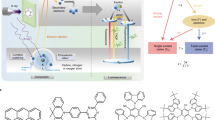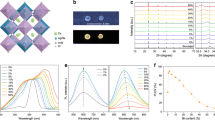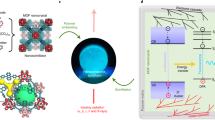Abstract
The architectural design and fabrication of low-cost and reliable organic X-ray imaging scintillators with high light yield, ultralow detection limits and excellent imaging resolution is becoming one of the most attractive research directions for chemists, materials scientists, physicists and engineers due to the devices’ promising scientific and applied technological implications. However, the optimal balance among X-ray absorption capability, exciton utilization efficiency and photoluminescence quantum yield of organic scintillation materials is extremely difficult to achieve because of several competitive non-radiative processes, including intersystem crossing and internal conversion. Here we introduced heavy atoms (Cl, Br and I) into thermally activated delayed fluorescence (TADF) chromophores to significantly increase their X-ray absorption cross-section and maintaining their unique TADF properties and high photoluminescence quantum yield. The X-ray imaging screens fabricated using TADF-Br chromophores exhibited highly improved X-ray sensitivity and imaging resolution compared with the TADF-H counterpart. More importantly, the high X-ray imaging resolution of >18.0 line pairs per millimetre achieved from the TADF-Br screen exceeds most reported organic and conventional inorganic scintillators. This study could help revive research on organic X-ray imaging scintillators and pave the way towards exciting applications for radiology and security screening.
This is a preview of subscription content, access via your institution
Access options
Access Nature and 54 other Nature Portfolio journals
Get Nature+, our best-value online-access subscription
$29.99 / 30 days
cancel any time
Subscribe to this journal
Receive 12 print issues and online access
$209.00 per year
only $17.42 per issue
Buy this article
- Purchase on Springer Link
- Instant access to full article PDF
Prices may be subject to local taxes which are calculated during checkout




Similar content being viewed by others
Data availability
The main data supporting the findings of this study are available within this Article and its Supplementary Information. Further data are available from the corresponding author on reasonable request. Source data are provided with this paper.
References
Chen, Q. et al. All-inorganic perovskite nanocrystal scintillators. Nature 561, 88–93 (2018).
Yu, D. et al. Two-dimensional halide perovskite as β-ray scintillator for nuclear radiation monitoring. Nat. Commun. 11, 3395 (2020).
Wu, H., Ge, Y., Niu, G. & Tang, J. Metal halide perovskites for X-ray detection and imaging. Matter 4, 144–163 (2021).
Liang, S. et al. Recent advances in synthesis, properties, and applications of metal halide perovskite nanocrystals/polymer nanocomposites. Adv. Mater. 33, e2005888 (2021).
Heo, J. H. et al. High-performance next-generation perovskite nanocrystal scintillator for nondestructive X-ray imaging. Adv. Mater. 31, e1801743 (2018).
Clinckemalie, L. et al. Challenges and opportunities for CsPbBr3 perovskites in low- and high-energy radiation detection. ACS Energy Lett. 6, 1290–1314 (2021).
Zhou, Y., Chen, J., Bakr, O. M. & Mohammed, O. F. Metal halide perovskites for X-ray imaging scintillators and detectors. ACS Energy Lett. 6, 739–768 (2021).
Pan, W. et al. Cs2AgBiBr6 single-crystal X-ray detectors with a low detection limit. Nat. Photon. 11, 726–732 (2017).
Wei, H. et al. Sensitive X-ray detectors made of methylammonium lead tribromide perovskite single crystals. Nat. Photon. 10, 333–339 (2016).
Xu, L. J., Lin, X., He, Q., Worku, M. & Ma, B. Highly efficient eco-friendly X-ray scintillators based on an organic manganese halide. Nat. Commun. 11, 4329 (2020).
Wei, J.-H. et al. All-inorganic lead-free heterometallic Cs4MnBi2Cl12 perovskite single crystal with highly efficient orange emission. Matter 3, 892–903 (2020).
Jana, A., Park, S., Cho, S., Kim, H. & Im, H. Bounce back with triplet excitons for efficient X-ray scintillation. Matter 5, 20–22 (2022).
Yang, B. et al. Lead-free halide Rb2CuBr3 as sensitive X-ray scintillator. Adv. Mater. 31, e1904711 (2019).
Han, K. et al. Seed crystal induced cold sintering toward metal halide transparent ceramic scintillators. Adv. Mater. 34, e2110420 (2022).
Ma, W. et al. Thermally activated delayed fluorescence (TADF) organic molecules for efficient X-ray scintillation and imaging. Nat. Mater. 21, 210–216 (2022).
Wang, J.-X. et al. Nearly 100% energy transfer at the interface of metal-organic frameworks for X-ray imaging scintillators. Matter 5, 253–265 (2022).
Gandini, M. et al. Efficient, fast and reabsorption-free perovskite nanocrystal-based sensitized plastic scintillators. Nat. Nanotechnol. 15, 462–468 (2020).
Wang, X. et al. Color-tunable X-ray scintillation based on a series of isotypic lanthanide–organic frameworks. Chem. Commun. 56, 233–236 (2019).
Wang, X. et al. Organic phosphors with bright triplet excitons for efficient X-ray-excited luminescence. Nat. Photon. 15, 187–192 (2021).
Galunov, N. et al. Delayed radioluminescence of some heterostructured organic scintillators. J. Lumin. 226, 117477 (2020).
Wang, J.-X. et al. Organic thermometers based on aggregation of difluoroboron β-diketonate chromophores. J. Phys. Chem. A 124, 10082–10089 (2020).
Wang, X. F. et al. Pure organic room temperature phosphorescence from excited dimers in self-assembled nanoparticles under visible and near-infrared irradiation in water. J. Am. Chem. Soc. 141, 5045–5050 (2019).
Zhang, X. et al. Ultralong phosphorescence cellulose with excellent anti-bacterial, water-resistant and ease-to-process performance. Nat. Commun. 13, 1117 (2022).
Wang, J.-X. et al. Tunable fluorescence and afterglow in organic crystals for temperature sensing. J. Phys. Chem. Lett. 13, 1985–1990 (2022).
Dai, W. et al. Halogen bonding: a new platform for achieving multi-stimuli-responsive persistent phosphorescence. Angew. Chem. Int. Ed. 61, e202200236 (2022).
Jeon, S. O. et al. High-efficiency, long-lifetime deep-blue organic light-emitting diodes. Nat. Photon. 15, 208–215 (2021).
Hirata, S. et al. Highly efficient blue electroluminescence based on thermally activated delayed fluorescence. Nat. Mater. 14, 330–336 (2015).
Yang, Z. et al. Recent advances in organic thermally activated delayed fluorescence materials. Chem. Soc. Rev. 46, 915–1016 (2017).
Wang, J.-X. et al. Organic composite crystal with persistent room-temperature luminescence above 650 nm by combining triplet–triplet energy transfer with thermally activated delayed gluorescence. CCS Chem. 2, 1391–1398 (2020).
Ding, D. et al. Highly efficient and color-stable thermally activated delayed fluorescence white light-emitting diodes featured with single-doped single emissive layers. Adv. Mater. 32, e1906950 (2020).
Luo, D., Chen, Q., Gao, Y., Zhang, M. & Liu, B. Extremely simplified, high-performance, and doping-free white organic light-emitting diodes based on a single thermally activated delayed fluorescent emitter. ACS Energy Lett. 3, 1531–1538 (2018).
Tang, L. et al. X-ray excited ultralong room-temperature phosphorescence for organic afterglow scintillators. Chem. Commun. 56, 13559–13562 (2020).
Dong, C. et al. Influence of isomerism on radioluminescence of purely organic phosphorescence scintillators. Angew. Chem. Int. Ed. 60, 27195–27200 (2021).
Chen, H. et al. Cesium lead halide nanocrystals based flexible X‐ray imaging screen and visible dose rate indication on paper substrate. Adv. Opt. Mater. 10, 2102790 (2022).
Han, L. et al. Photophysics in zero‐dimensional potassium‐doped cesium copper chloride Cs3Cu2Cl5 nanosheets and its application for high‐performance flexible X‐ray detection. Adv. Opt. Mater. 10, 2102453 (2022).
Liu, Y. et al. Large lead‐free perovskite single crystal for high‐performance coplanar X‐ray imaging applications. Adv. Opt. Mater. 8, 2000814 (2020).
Lian, L. et al. Highly luminescent zero-dimensional organic copper halides for X-ray scintillation. J. Phys. Chem. Lett. 12, 6919–6926 (2021).
Zhang, Y. et al. Metal halide perovskite nanosheet for X-ray high-resolution scintillation imaging screens. ACS Nano 13, 2520–2525 (2019).
Wang, J.-X. et al. Perovskite-nanosheet sensitizer for highly efficient organic X-ray imaging scintillator. ACS Energy Lett. 7, 10–16 (2021).
Kretzschmar, A., Patze, C., Schwaebel, S. T. & Bunz, U. H. Development of thermally activated delayed fluorescence materials with shortened emissive lifetimes. J. Org. Chem. 80, 9126–9131 (2015).
Kim, H. S. et al. Enhancement of reverse intersystem srossing in charge‐transfer molecule through internal heavy atom effect. Adv. Funct. Mater. 31, 2104646 (2021).
Berger, M. J. et al. XCOM: Photon Cross Sections Database (National Institute of Standards and Technology, 2013); https://www.nist.gov/pml/xcom-photoncross-sections-database
El-Ballouli, A. O. et al. Quantum confinement-tunable ultrafast charge transfer at the PbS quantum dot and phenyl-C61-butyric acid methyl ester interface. J. Am. Chem. Soc. 136, 6952–6959 (2014).
Wadt, W. R. & Hay, P. J. Ab initio effective core potentials for molecular calculations. Potentials for main group elements Na to Bi. J. Chem. Phys. 82, 284–298 (1985).
Gao, X. et al. Evaluation of spin-orbit couplings with linear-response time-dependent density functional methods. J. Chem. Theory Comput. 13, 515–524 (2017).
Warburton, W. K., Carlson, J. S. & Feng, P. L. Organic glass scintillator (OGS) property comparisons to stilbene, EJ-276 and BC-404. Nucl. Instrum. Methods Phys. Res. B 1018, 165778 (2021).
Chen, W. et al. All‐inorganic perovskite polymer-ceramics for flexible and refreshable X‐ray imaging. Adv. Funct. Mater. 32, 2107424 (2021).
Acknowledgements
This work was supported by the King Abdullah University of Science and Technology (KAUST).
Author information
Authors and Affiliations
Contributions
J.-X.W. and O.F.M. conceived the project. J.-X.W. synthesized the TADF chromophores, prepared the films for measurements and applications, performed the steady-state experiments and some time-resolved experiments, and analysed the data. L.G.A. performed the TA and TCSPC measurements as well as the DFT calculations. J.-X.W., X.W. and Y.Z. performed and analysed the scintillation measurements. T.H. synthesized the CsPbBr3 nanosheet. O.M.B and M.E. contributed to the discussion of the experimental data and provided valuable suggestions. O.F.M. supervised the project and suggested the analysis of the experimental data. J.-X.W. and O.F.M. co-wrote the manuscript.
Corresponding author
Ethics declarations
Competing interests
O.M.B. is a founder of Quantum Solutions, a company that develops optoelectronic devices. The other authors declare no competing interests.
Peer review
Peer review information
Nature Photonics thanks Kris Iniewski and the other, anonymous, reviewer(s) for their contribution to the peer review of this work.
Additional information
Publisher’s note Springer Nature remains neutral with regard to jurisdictional claims in published maps and institutional affiliations.
Supplementary information
Supplementary Information
Supplementary Figs. 1–8, Tables 1–4 and material synthesis.
Source data
Source Data Fig. 2
Statistical source data.
Source Data Fig. 3
Statistical source data.
Source Data Fig. 4
Statistical source data.
Rights and permissions
Springer Nature or its licensor holds exclusive rights to this article under a publishing agreement with the author(s) or other rightsholder(s); author self-archiving of the accepted manuscript version of this article is solely governed by the terms of such publishing agreement and applicable law.
About this article
Cite this article
Wang, JX., Gutiérrez-Arzaluz, L., Wang, X. et al. Heavy-atom engineering of thermally activated delayed fluorophores for high-performance X-ray imaging scintillators. Nat. Photon. 16, 869–875 (2022). https://doi.org/10.1038/s41566-022-01092-x
Received:
Accepted:
Published:
Issue Date:
DOI: https://doi.org/10.1038/s41566-022-01092-x
This article is cited by
-
Efficient and ultrafast organic scintillators by hot exciton manipulation
Nature Photonics (2024)
-
Dual heterogeneous interfaces enhance X-ray excited persistent luminescence for low-dose 3D imaging
Nature Communications (2024)
-
Water-dispersible X-ray scintillators enabling coating and blending with polymer materials for multiple applications
Nature Communications (2024)
-
Electron beam-induced white emission from iridium complexes-doped polymer dots
Photochemical & Photobiological Sciences (2024)
-
Efficient X-ray luminescence imaging with ultrastable and eco-friendly copper(I)-iodide cluster microcubes
Light: Science & Applications (2023)



